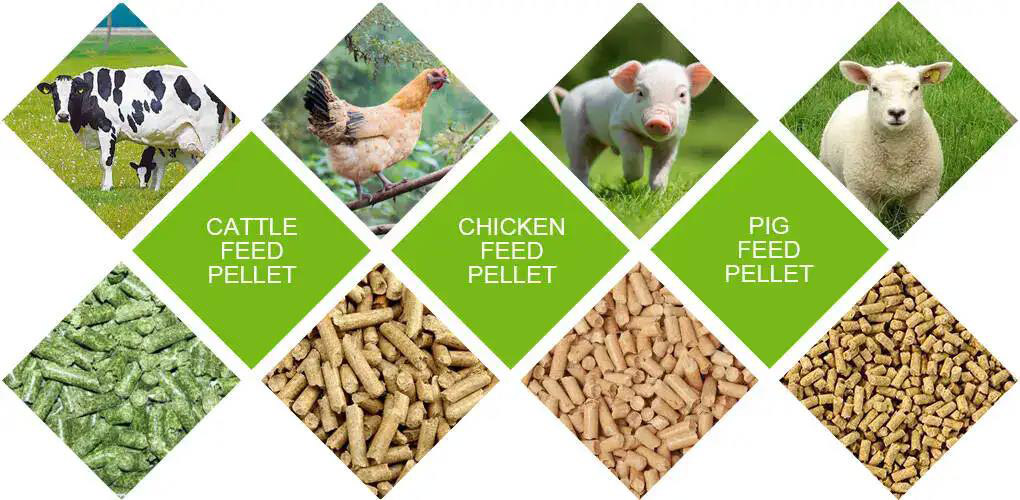Sheep feed pellet machines refer to a series of equipment and processes used for producing sheep feed. These pellet machines typically include multiple stages, designed to process various raw materials into feed products suitable for sheep consumption.
The structure of a sheep feed pellet machine typically comprises several key components:
Serving as the power source of the pellet machine, the motor provides the necessary rotational force to drive the entire operation of the machine.
The frame acts as the supporting structure of the pellet machine, securing the machine body and motor in place to ensure stability during operation.
The motor generates power that, when passed through the reducer, is used to decrease the speed and increase the torque. This adjustment is necessary to provide the appropriate force for pressing pellets.
This is the core part of the pellet machine, containing several critical components, such as:
These wheels apply high pressure to compress the material into pellets.
We design the die plate with multiple holes to extrude and form the material into pellets.
Used to trim the pellets to the desired length.
The finished pellets are expelled through this outlet.
This is where the raw material is stored, ensuring a continuous supply for pressing.
These components work in concert to effectively transform powdered or crushed raw materials into pellet feed suitable for sheep consumption. The design of the pellet machine focuses on being efficient, energy-saving, easy to operate, high in efficiency, and long-lasting, to enhance the benefits of the breeding industry and strengthen the competitiveness of the feed industry. By employing this mechanized production method, we can not only enhance the nutritional value of the feed and improve its digestibility and absorption rate but also reduce waste and decrease production costs.

Typically, the production of sheep feed pellet machine uses raw materials such as corn, soybeans, wheat, and other nutrients as the formula. Our feed pellet machine are specially used to produce feed for poultry, livestock, pigs, horses, cattle, sheep, chickens, ducks, goose and other animals.For different animals, with different growth cycles, (chicks, suckling pigs, calves, etc.), the feed pellet size required is different, but our feed production line only needs to replace ring molds with different apertures or use a pellet crumbler to reach the required size.

We mainly reflect the advantages of sheep feed production lines in the following aspects:
Sheep feed production lines significantly improve the efficiency of feed production through automation and mechanization. The production line can continuously carry out processes such as raw material reception, cleaning, crushing, mixing, pelleting, cooling, screening, and packaging, greatly reducing the need for manual operations and saving time and labor.
The standardized operations of the production line ensure the consistency and stability of the feed product quality. By using precise formulas and mixing ratios, as well as strictly controlled production conditions, it is possible to produce nutritionally balanced and reliable sheep feed.
Sheep feed production lines can adjust formulas and production processes according to the growth stages and nutritional needs of different sheep, producing specialized feed suitable for lambs, fattening sheep, and breeding sheep, thus meeting the diverse demands of the market.
Through scaled production and optimized raw material mixing, sheep feed production lines help to reduce the cost of feed production. Additionally, the high efficiency of the production line also reduces energy consumption and waste, further lowering costs.
The design of sheep feed production lines usually takes into account the needs of farms and feed processing plants of different scales. They can be customized and expanded according to the actual production scale, demonstrating strong adaptability.
High-quality sheep feed is crucial for improving the growth rate of sheep, enhancing meat quality, and increasing breeding benefits. The application of sheep feed production lines provides a stable and reliable source of feed for the breeding industry, promoting its healthy development.
Modern sheep feed production lines consider environmental protection requirements in their design, such as reducing dust emissions, noise control, and wastewater treatment, helping to minimize the environmental impact of the production process.
With the advancement of technology, sheep feed production lines are continuously introducing new technologies, such as intelligent control, precise nutrition, and biotechnology, to improve the nutritional value of feed and production efficiency while reducing environmental impact.
In summary, the application of sheep feed production lines is of great significance for enhancing the specialization, scale, and technological level of feed production. It plays an active role in promoting the development of the breeding industry and ensuring the quality and safety of animal products.
| Model | Capacity | Main Motor Power | Feeder Motor Power | Conditioner Power | Dia. of Ring Die | Pellet Size |
| SZLH250 | 1-2T/H | 22KW | 0.75kw | 1.5kw | 250mm | 2-12mm |
| SZLH320 | 3-4T/H | 37KW | 1.5kw | 2.2kw | 320mm | 2-12mm |
| SZLH350 | 5-7T/H | 55KW | 1.5kw | 3kw | 350mm | 2-12mm |
| SZLH420 | 8-12T/H | 110KW | 1.5kw | 7.5kw | 420mm | 2-12mm |
| SZLH508 | 10-18T/H | 160KW | 2.2kw | 11kw | 508mm | 2-12mm |
| SZLH558 | 15-25T/H | 180KW | 2.2kw | 11kw | 558mm | 2-12mm |
| SZLH678 | 20-30T/H | 220KW | 2.2kw | 11kw | 678mm | 2-12mm |
| SZLH768 | 25-42T/H | 280KW | 2.2kw | 11kw | 768mm | 2-12mm |